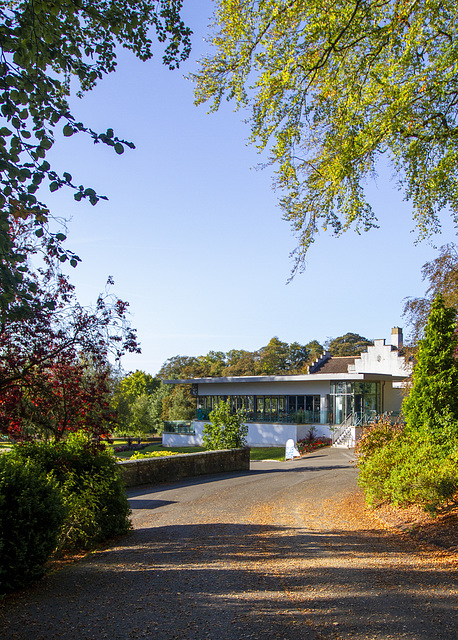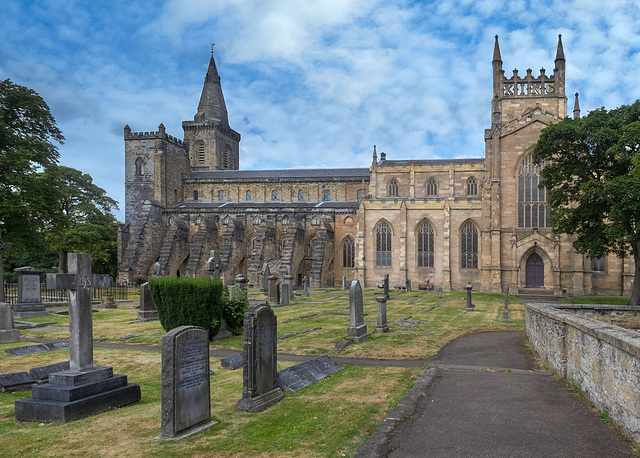
Dunfermline
27 Sep 2014
11 favorites
6 comments
Wee Bridge, The Glen, Dunfermline
Pittencrieff Park (known locally as "The Glen") is a public park in Dunfermline, Fife, Scotland. It was purchased in 1902 by the town's most famous son, Andrew Carnegie, and given to the people of Dunfermline in a ceremony the following year. Its lands include the historically significant and topologically rugged glen which interrupts the centre of Dunfermline and, accordingly, part of the intention of the purchase was to carry out civic development of the area in a way which also respected its heritage. The project notably attracted the attention of the urban planner and educationalist, Patrick Geddes. The glen is an area of topographical and historical significance to Dunfermline as the original site of Malcolm's Tower, the probable remains of which can be identified today on a strongly defendable outcrop of rock. To the eastern side of the park is Dunfermline Palace with Dunfermline Abbey and to the west it overlooks the village of Crossford. Quoted from Wikipedia
27 Sep 2014
11 favorites
10 comments
The Peacock Rooms, The Glen, Dunfermilne
I love the cherry scones here!
The Peacock Rooms Cafe is the place to eat and drink in Pittencrieff Park. It is open from 10am to 4.30pm in the summer, seven days a week, serving a delicious selection of hot and cold food and drinks. Quoted from the Pittencrieff Park website
27 Sep 2014
7 favorites
10 comments
Gazebo in the Glen
Pittencrieff Park (known locally as "The Glen") is a public park in Dunfermline, Fife, Scotland. It was purchased in 1902 by the town's most famous son, Andrew Carnegie, and given to the people of Dunfermline in a ceremony the following year. Its lands include the historically significant and topologically rugged glen which interrupts the centre of Dunfermline and, accordingly, part of the intention of the purchase was to carry out civic development of the area in a way which also respected its heritage. The project notably attracted the attention of the urban planner and educationalist, Patrick Geddes. The glen is an area of topographical and historical significance to Dunfermline as the original site of Malcolm's Tower, the probable remains of which can be identified today on a strongly defendable outcrop of rock. To the eastern side of the park is Dunfermline Palace with Dunfermline Abbey and to the west it overlooks the village of Crossford. Quoted from Wikipedia
20 Sep 2014
13 favorites
10 comments
Royal Palace of Dunfermline
Charles I (19 November 1600 – 30 January 1649)[a] was King of England, Scotland, and Ireland from 27 March 1625 until his execution in 1649. He was born into the House of Stuart as the second son of King James VI of Scotland, but after his father inherited the English throne in 1603 (as James I), he moved to England, where he spent much of the rest of his life. He became heir apparent to the three kingdoms of England, Scotland, and Ireland in 1612 on the death of his elder brother Henry Frederick, Prince of Wales. An unsuccessful and unpopular attempt to marry him to the Spanish Habsburg princess Maria Anna culminated in an eight-month visit to Spain in 1623 that demonstrated the futility of the marriage negotiations. Two years later he married the Bourbon princess Henrietta Maria of France. Quoted from Wikipedia
16 Jul 2018
12 favorites
14 comments
Dunfermline Abbey Entrance
Dunfermline Abbey is a Church of Scotland Parish Church in Dunfermline, Fife, Scotland. The church occupies the site of the ancient chancel and transepts of a large medieval Benedictine abbey, which was sacked in 1560 during the Scottish Reformation and permitted to fall into disrepair. Part of the old abbey church continued in use at that time and some parts of the abbey infrastructure still remain. Dunfermline Abbey is one of Scotland's most important cultural sites. Quoted from Wikipedia
16 Jul 2018
6 favorites
8 comments
Dunfermline Abbey
Autumn of the year 1832 was a deadly one for the population of Dunfermline. The cholera outbreak in Scotland had its origin in Sunderland, a ship had brought the deadly bacteria into the port. The first case was reported the day before Christmas 1831. A few months later, when the epidemic had already been ravaging England and the central belt of Scotland, it finally arrived in Dunfermline. And there it killed. Quoted from the Graveyards of Scotland website
16 Jul 2018
17 favorites
18 comments
Abbot House, Maygate, Dunfermline
Abbot House is the oldest building in Dunfermline. Lying in the shadow of Dunfermline's great abbey church, the core of the building is 16th-century. Quoted from Wikipedia
16 Jul 2018
5 favorites
2 comments
Dunfermline Town Hall
Dunfermline City Chambers is a municipal facility at the corner of Bridge Street and Kirkgate in Dunfermline, Fife. The building, which serves as home to the local area committee of Fife Council, is a Category A listed building. Quoted from Wikipedia
16 Jul 2018
10 favorites
14 comments
Dunfermline Abbey, Buttresses
Dunfermline Abbey is a Church of Scotland Parish Church in Dunfermline, Fife, Scotland. The church occupies the site of the ancient chancel and transepts of a large medieval Benedictine abbey, which was sacked in 1560 during the Scottish Reformation and permitted to fall into disrepair. Part of the old abbey church continued in use at that time and some parts of the abbey infrastructure still remain. Dunfermline Abbey is one of Scotland's most important cultural sites. Quoted from Wikipedia
Jump to top
RSS feed- Latest items - Subscribe to the latest items added to this album
- ipernity © 2007-2024
- Help & Contact
|
Club news
|
About ipernity
|
History |
ipernity Club & Prices |
Guide of good conduct
Donate | Group guidelines | Privacy policy | Terms of use | Statutes | In memoria -
Facebook
Twitter










